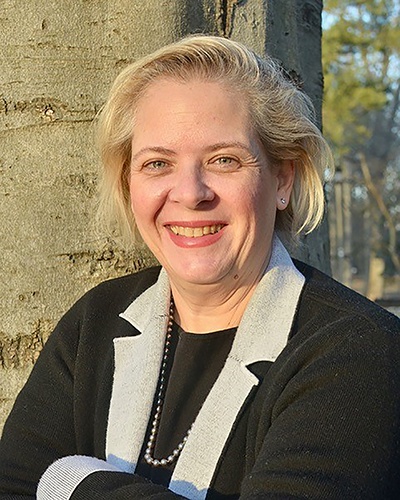
Ronna Weber recently assumed the position of executive director of the National Association of State Directors of Pupil Transportation Services (NASDPTS). Previously, Weber served as executive director of the National School Transportation Association (NSTA), as well as a speaker and attendee at many NASDPTS Annual Conferences.
School BUSRide spoke with Weber about her new role, and how she views the pupil transportation industry moving forward in 2021.

What most excites you about your new role at NASDPTS?
That is a big question. I have spent over 20 years in the school transportation industry with a primary focus on the contracted side of the industry. I thoroughly enjoyed my time with that focus and really learned a lot, both from an operational side, but also from the policy, regulatory and legislative sides. This opportunity presents a different look at the industry. It is the ability and the opportunity to spend time with the state directors and to really understand their different perspectives. And it is a whole-state approach. It is a great marriage of the knowledge that I have, plus the parts about which I am learning.
What is your view on collaboration between NASDPTS and other associations, and within the industry as a whole?
The industry is always strongest when it speaks with one voice, no matter the issue. It is most important for us to work together and be able to speak together to that issue. It does not matter whether it is on the Hill or within our own industry, we are stronger together.
If you get to know each other and you begin to understand each other, you can more easily find common ground. But if you can really understand each other, the chances of working through disagreements are much greater. For me, that collaboration is vital and is alive and well. I have regular calls with Mike Martin and Curt Macysyn – executive directors of NAPT and NSTA, respectively. We email and text and talk to each other regularly. Those conversations help us find commonality. It is for the good of the industry and for the good of the associations for us to work together as often as we can.
You previously served as head of the NSTA. What were some of the top lessons learned from that period of your career?
It is a great association management tool to really sit down and figure out how a member got where they are, why they are here, what interests them, what excites them about being part of this group and this industry, and then figuring out how to channel that for the association or how to channel that for the issue or the movement on which you are working. What we do requires very few paid people, but requires a lot of volunteers and association management must be able to understand how all the puzzle pieces fit together. It is important for any association to have the right people in place, and you only get there by knowing the people and by understanding what motivates those people.
What are your thoughts on the industry’s transition toward electric vehicles?
It is obviously a huge issue regardless of where any local entity and city or state may find itself. Being as educated as possible is really important. There are a lot of different variables and there are a lot of different stages to bring this into your fleet. It is just not something you do overnight. So get as educated as you can, and understand your partners as well as all the different parts and pieces and how they all fit together. Make sure you are coordinating with your power company about how you are going to use those vehicles.
This is an issue that we all need to get our hands around, because it is something we all need to understand and not just jump in to blindly.
What do you see as the top goals and challenges for the industry in the coming years?
COVID-19 blindsided the industry in so many ways. We must get our hands around what the pandemic has done to the industry and how we get out of that. Do we see a change? For example, does school bus ridership when kids returned to school in the fall, go back to pre-pandemic levels? Do we need to address that issue? Where are we on all of the facets of this? Are we able to turn our focus to increasing school bus capacity or are we still limited by health restrictions?
The number one issue facing the industry is the driver shortage. How will we ensure we have enough drivers by the fall to manage school start-ups? What can we do now to help?
Figuring out where we are by the Fall and the adjustments and changes we need to make will be crucial. Then we need to understand where the industry finds itself and if there are any additional changes ahead.
Finding time to look down the road when every week brings so many changes it is like a new first week of school every single week, but we must look ahead so we are ready.
How do you see alternative school transportation impacting our industry?
I think alternative transportation offers some opportunities, but it also creates some challenges. We have to step back to be sure the kids are safe, and they are in the safest environment possible. We know that the safest environment is a school bus, and we still seem to struggle to get that message out so that it resonates with parents. We have an educational opportunity.
It is attractive to turn to something like an alternative transportation company to solve the driver shortage problem, but will it work as a long-term solution? Does it create some unintended consequences? Have we really thought through all of the variables? What about pickup and drop off? What about checking your child out of school? How safe is your child? What background checks have been done on the driver? We must be sure we are having an “apples to apples” comparison.
Some companies do a better job at that than others, and parents do not realize that. Parents assume it is all good, or it would not be an option – and that is not always true. I think we have to be sure that these things are very clear and that really does go to the local level, the local PTA conversation or the local school board conversation so everyone understands what that means.
What is in the near-term future for NASDPTS?
I come to NASDPTS from a totally different perspective. Historically, executive directors have been past state directors. Obviously, that is not me and I do not have that skillset. But I do have association management experience, which past executive directors have never had.
I understand the policy side from my years working with Capitol Hill and working with associations like NSTA. I am currently focused on trying to know state directors and getting to understand their priorities and concerns. How best can the association help them? What has worked in the past, what has not worked, what opportunities do we have, where can we create some different energy? How can we help them get better?
I am excited to be back with the school transportation industry – there is truly no other industry like the school transportation industry. I am excited to be working with old friends and getting to know new ones as well.


